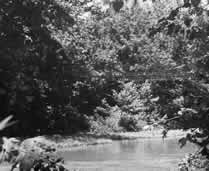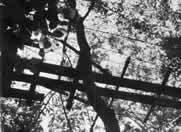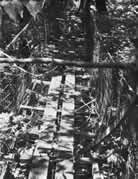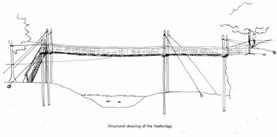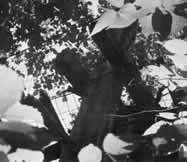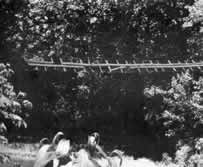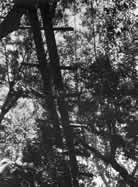 |
Volume I, No. 1, Fall 1973 |
The Swinging Bridge
Over a century ago the school districts in the Missouri Ozark region were not divided geographically, but into squares with each containing six to nine square miles. By placing the school house in the middle of the square no one had to walk more than two miles to reach school. For most school districts this plan worked, but to the children of the Stony Point school district, the plan presented a unique problem because the Osage Fork River divided the district into two almost equal parts. How to get the children across the river so they could attend the school became a real community problem, for the only crossings for miles were fords.
[50]
After considerable planning the members of the school board resolved the problem by constructing a swinging foot bridge at a halfway place where there was already a natural ford and well used travel way. The patrons of the district built one of wooden slabs about 1912. Since it reached only from one side of the river to the opposite bank, this bridge had one big disadvantage. On the east side of the river the bridge came out in front of a twenty foot limestone bluff. The students had to climb the near vertical rocks or walk down the river until they could find a place where it was easier to climb to reach the path through the timber Wading to the school, for the road went in another direction.
To solve this problem, when the big overflow in 1914 took out the first bridge, the patrons again provided the labor at twenty-five cents an hour to build a better bridge. This bridge came out at the top of the bluff instead of at the bottom and was well above flood waiters. About one-third of the new bridge was suspended over dry land. Large oak and cedar trees on each side provided vertical support for four steel cables that spanned about a hundred feet between the rock bluff and the other bank. For added strength, cables were tied to huge logs buried in the ground.
Fastened securely between the hand-twisted wire cables, welded wire formed two sides about three Feet high and a bottom about Four feet wide. Stapled crosswise to the wire in the bottom were two-by-fours placed four feet apart. On these, one-by-sixes were nailed four inches apart to provide a walkway across the bridge.
On the west side of the bridge steps were constructed to reach up to the walkway which was about ten feet from the ground. The steps, protected by hand rails and made of sturdy oak two-by-sixes were placed close together so the smaller children could ascend them easily and safely.
The bridge proved to be very rugged and required surprisingly little maintenance. Portions of the wooden walkway had to be replaced occasionally, but the steps needed repairing less often because the large trees offered protection from the elements and because the native oak is so durable. This is really remarkable when you consider the beating the bridge has taken from the children, and the years.
Although each season presented its own problems, winter was the worst for crossing the bridge. Due to the spaces left in the flooring of the bridge, snow could not form in the winter. However, ice certainly would, and when this occured, the bridge would become very slick and hard to cross. The older boys would help the first and second graders by placing the smaller children's feet on top of their own and walking them across the bridge.
[51]
Flash floods due to heavy rains were a year round danger. The water would never get up to the bridge, but would fill the slough, flood the bottom field over which the children walked to get to the bridge, and sometimes would rise well up the steps on the west bank. The older boys sometimes would swim horses across the low slouch nearest the bridge to pick up the children as they came home across the bridge. Sometimes the river would rise so far that it was too dangerous for the horses to swim. If this happened when the children were at school, they stayed all night with neighbors on the school side of the river. If it happened during the night, those children had a holiday that day.
Structural drawing of the footbridge
Because the bridge was one of the few in the region, it proved to be quite an attraction.
Oak posts provided vertical support for the walk way.
Relatives and friends that came to visit school patrons wanted to see and walk across the bridge, However, most of the children that grew up around the bridge did not find it particularly interesting. The majority were not afraid of the bridge and crossed it daily like they were walking through a field. On the other hand there were some weak-hearted students years ago that would not cross the bridge. They used a flat-bottomed johnboat which was the only means of crossing the river before the bridge was built.
Many times the eighth grade boys would catch smaller children out on the bridge and frighten them by making the bridge sway. This would really terrorize the youngest children because the bridge, a good twenty feet from the surface of the water, probably looked a great deal higher to those youngsters. Actually, it was almost impossible to fall from the bridge because the welded wire bottom and sides would catch anyone who slipped off the walkway.
I have visited the swinging bridge four times and I am still amazed at the durability of the bridge which hasn't been used or repaired since used by the last child in 1961. It leans to the left now and some boards on the walkway are rotted, but the rusty cables and wire are surprisingly strong. The oak trees anchoring the cables are vigorous. With care even the steps can still be walked on.
There is no sign now of the former ford in the river for horse drawn vehicles. The once frequently traveled road is now only the farmer's access to his field, but the foot bridge, almost hidden by trees, is still suspended over the small springfed river, a reminder to the few fishermen who pass under it, of the care and interest the people of the Ozarks have always had in their children's education.
[53]
Copyright © 1981 BITTERSWEET, INC.
Next Article | Table of Contents | Other Issues
